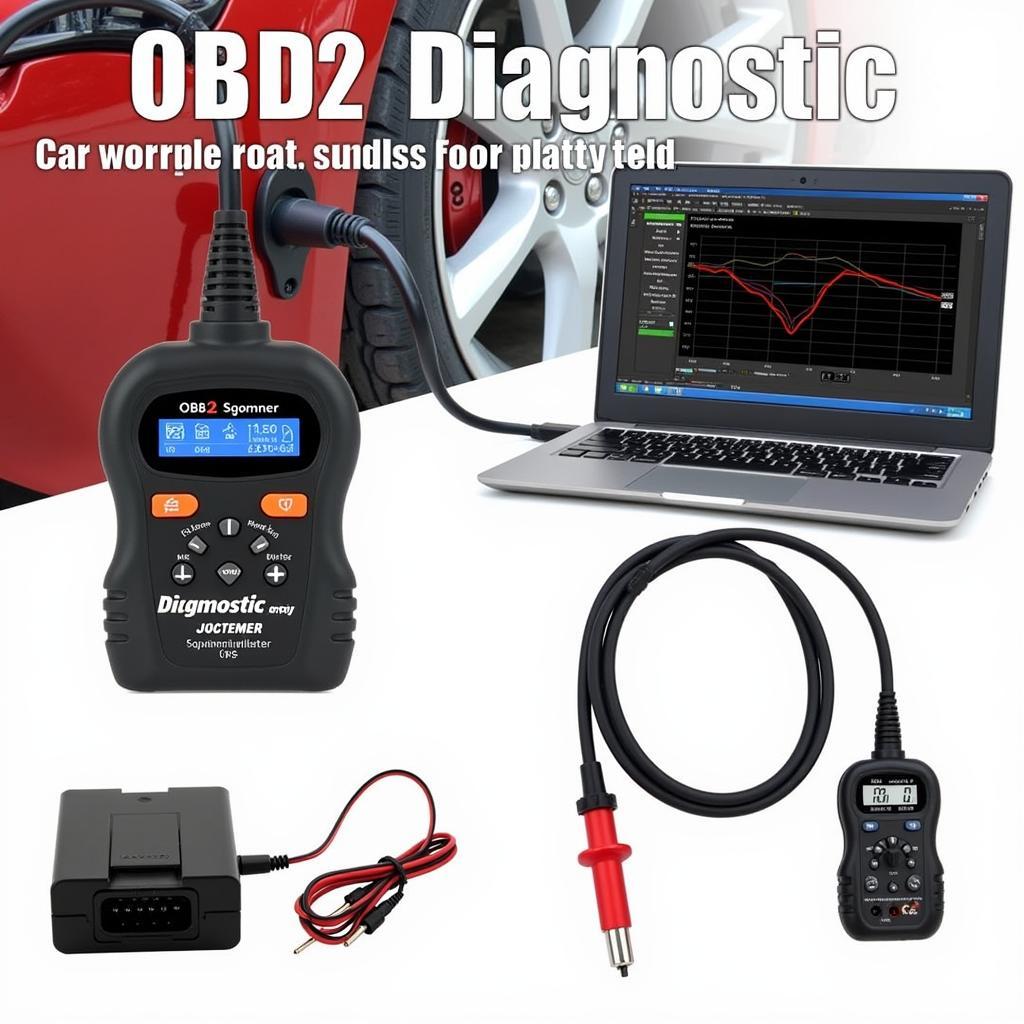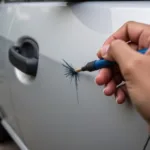Modern vehicles are complex machines, and understanding how to perform car diagnostics is crucial for maintaining their health and addressing issues promptly. Whether you’re a DIY enthusiast or just want to be more informed before visiting a mechanic, this guide will provide you with the essential knowledge and steps to effectively diagnose your car’s problems.
Understanding the Importance of Car Diagnostics
Diagnosing car problems used to involve a lot of guesswork. Mechanics would rely heavily on experience and visual inspections. Today, how to perform car diagnostics with laptop is becoming increasingly common, providing precise and efficient troubleshooting. Early diagnosis can prevent minor issues from escalating into major, costly repairs. It also allows you to address problems before they impact your car’s performance, fuel efficiency, and overall safety.
 OBD2 Scanner and Diagnostic Tools
OBD2 Scanner and Diagnostic Tools
Essential Tools for Car Diagnostics
Before diving into the process, let’s look at the tools you’ll need. Some basic tools can help you identify simple issues, while more advanced tools offer comprehensive diagnostic capabilities. Here’s a breakdown:
- OBD2 Scanner: This handheld device plugs into your car’s OBD2 port (usually located under the dashboard) and reads diagnostic trouble codes (DTCs). These codes provide clues about the nature of the problem.
- Multimeter: A multimeter measures voltage, current, and resistance, allowing you to test various electrical components like sensors, fuses, and wiring.
- Code Reader: Similar to an OBD2 scanner, a code reader retrieves DTCs. However, it typically doesn’t offer advanced features like live data streaming.
- Diagnostic Software: For more in-depth diagnostics, software can be used in conjunction with an OBD2 scanner or interface. This software provides access to more detailed information and allows for advanced functions like actuator tests. You may need to learn how to perform car diagnostics with laptop to effectively utilize such software.
Performing Car Diagnostics: A Step-by-Step Guide
Now, let’s walk through how to perform car diagnostics using an OBD2 scanner and diagnostic software.
- Locate the OBD2 Port: Usually found under the dashboard on the driver’s side.
- Connect the OBD2 Scanner: Plug the scanner into the port.
- Turn the Ignition On: Turn the key to the “on” position without starting the engine.
- Read the Codes: Use the scanner or software to retrieve the DTCs.
- Interpret the Codes: Look up the codes online or in a repair manual to understand what they indicate.
- Clear the Codes: After addressing the issue, use the scanner to clear the codes.
- Retest: Drive the car and re-scan to ensure the problem is resolved. If you are exploring options to improve your car’s performance, you might want to consider resources like change car diagnostics and performance machine.
How to Use a Diagnostic Car Key Reader
A diagnostic car key reader is another useful tool, particularly for issues related to the car’s immobilizer system or key fobs. These readers can diagnose key problems, program new keys, and troubleshoot immobilizer issues.
What are the Best Car Diagnostic Tools Available on the Market?
If you’re serious about DIY car maintenance, investing in the best car diagnostic tool available on the market can save you money and headaches in the long run. These tools offer advanced features, comprehensive code databases, and often come with software for in-depth analysis. You can even find valuable resources like takealot car diagnostic scanners to compare and purchase quality diagnostic equipment.
Conclusion
Performing car diagnostics empowers you to take control of your vehicle’s maintenance. By understanding how to use the right tools and interpret diagnostic information, you can identify problems early, prevent costly repairs, and keep your car running smoothly.
FAQ
- What is an OBD2 port? The OBD2 port is a standardized connector used to access a vehicle’s diagnostic system.
- What are DTCs? Diagnostic Trouble Codes (DTCs) are codes that indicate specific malfunctions within the vehicle’s systems.
- Can I fix all car problems myself after diagnosing them? While diagnosing problems is a crucial first step, some repairs may require specialized tools or professional expertise.
- How often should I perform car diagnostics? It’s a good practice to scan your car for codes periodically, even if there are no apparent issues.
- Are there free car diagnostic software options available? Yes, there are some free options available, but they may have limited functionalities compared to paid software.
- What are some common car problems that diagnostics can detect? Diagnostics can detect issues with the engine, transmission, brakes, emissions system, and other critical components.
- Can car diagnostics tell me when my car needs an oil change? Some advanced diagnostic tools can provide insights into oil life and maintenance schedules.
For support, contact us via WhatsApp: +1(641)206-8880 or Email: [email protected]. We have a 24/7 customer support team.

